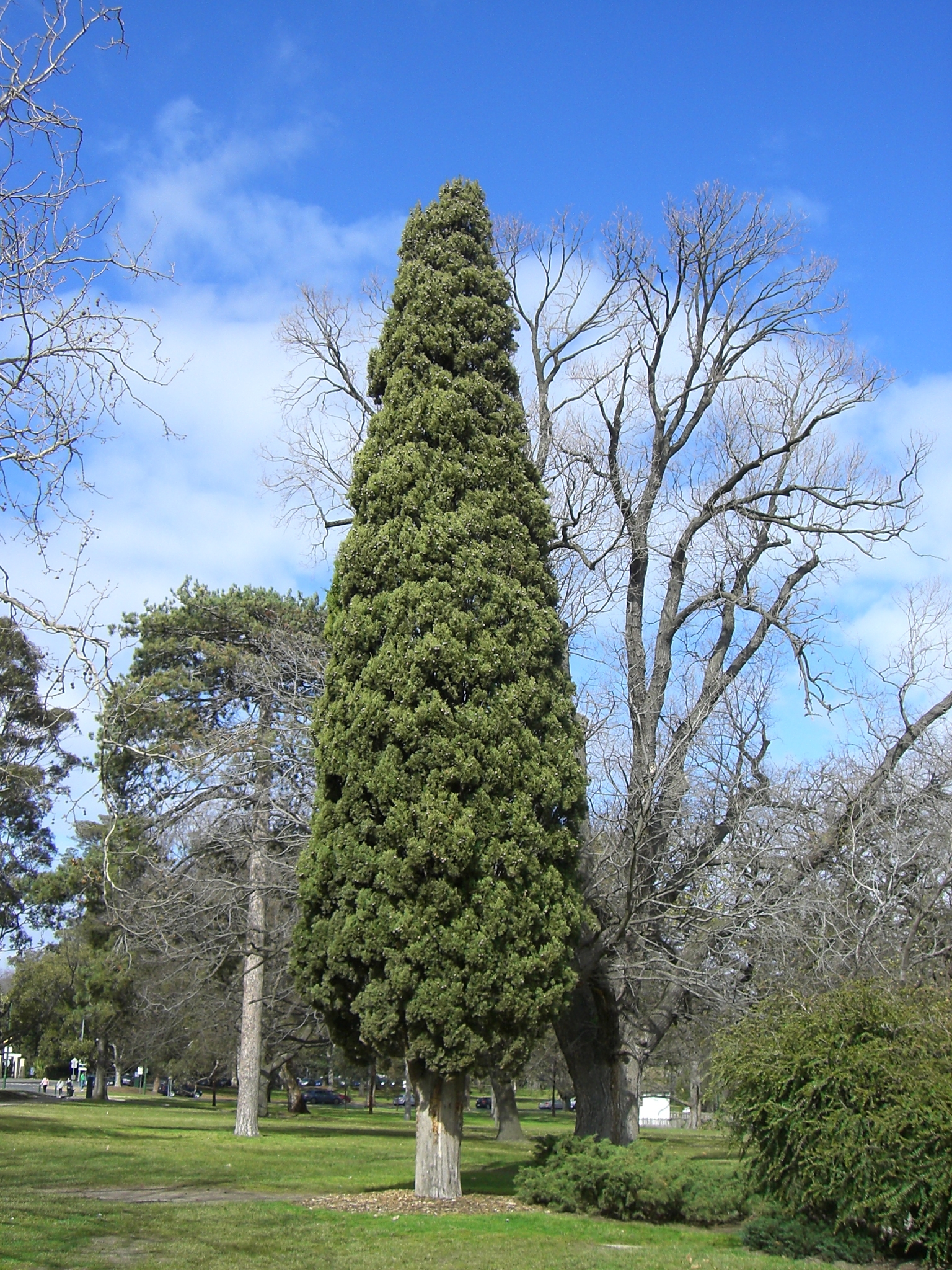
Tree occasionally attaining a height of up to 40 m. In cultivation it is invariably narrow-columnar to conical although the wild specimens of southern Europe have spreading branches. Bark thin, grey-brown, slightly fissured and flaky. Branchlets divided 3 times and thin at the tips, slightly curved and generally with flattened minor sprays. Leaves blunt and relatively small, mostly dusty grey-green; glands inconspicuous. Male cones about 3 mm long, terminal on short shoots Sept.-Oct onwards. Female cones mostly oblong and lumpy, 2-3.5 cm long, dark brown, becoming greyish; scales 8-12 or occasionally 14. Seed smooth and dull.
The common name Italian Cypress probably refers to the large number of these plants grown in Italy rather than to its natural distribution. Trees of natural populations in the eastern Mediterranean frequently display widespreading horizontal branches and are distinguished botanically as C. sempervirens f. horizontalis (Mill.) Voss, Wild Mediterranean Cypress. Although advertised in nineteenth century nursery catalogues this widespreading form does not remain and is rarely cultivated in Australia. A specimen can be seen at Hobart in the Royal Tasmanian Botanic Gardens. Grows naturally on limestone hillsides but in cultivation will tolerate a range of soil conditions. Recognition: Narrow conical or columnar habit; dusty dull green foliage; slender slightly flattened minor sprays; large, lumpy cones.
S Europe.
SA: Mt Gambier (Bot. Gds); Mylor (Rockford Estate, 2 trees in front of main house); Penola (Memorial Park; Yallum Park); Urrbrae (opposite Urrbrae House, Waite Agricultural Research Institute). ACT: City Hill (ptd c. 1880); Commonwealth Ave (Hyatt Hotel); Duntroon (Officers' Mess); Royal Canberra Hospital. NSW: Bowral (Anglican Church; Public School); Grong Grong; Orange (Cook Park; 'Duntry League' Golf Club); Sydney (N Parramatta, Cumberland Hospital, 2 trees in Wisteria Garden, one next to Pine Cottage all c. 15 m tall; Royal Bot. Gds near Pyramid Glasshouse; Rozelle, Rozelle Hospital inland side of Waterside Drive, c. 15 m tall); Wellington (Uniting Church). VIC: Avoca (cemetery, many); Bickleigh Vale ('Glencairn'); Burnley (V.C.A.H., 18 m in 1989, ptd c. 1891); Castlemaine (Bot. Gds; Campbell's Creek Cemetery, possibly supplied by F. Mueller); Croydon (side of road in shopping centre opposite Brushy Creek Hall. Label: 'This tree was planted by Hugh O'Rourke in front of his 'Brushy Creek' Hotel in 1855' Croydon Historical Society); Geelong (Western Cemetery, outstanding specimens); Glenormiston (College); Hawthorn (Methodists Ladies College); Heidelberg (Park); Kew (Boroondara Cemetery); Kurrumburra (Primary School); Kyneton (Church); Learmonth (Town Hall); Maldon (cemetery; behind Wesleyan Church; behind Museum); Melbourne (Royal Bot. Gds, edge of Central Lake); Malvern (Central Park; Hedgeley Dene Gds); Murchison (Cemetery); St Arnaud (Bot. Gds both sides of entrance); Terang (Cemetery). TAS: Hobart (Royal Tasmanian Bot. Gds; St David's Park); Franklin Village ('Franklin House'); Hagley (St Marys Church, 2 trees); Plenty (Salmon Ponds); Ouse.
Source: (1995). Cupressaceae. In: . Horticultural Flora of South-eastern Australia. Volume 1, Ferns, conifers & their allies. The identification of garden and cultivated plants. University of New South Wales Press.

Cupressus sempervirens 'Glauca'
Foliage waxy blue. Monrovia Nsy, USA.
Cupressus sempervirens 'Karoonda'
Rigid, upright producing many cones; foliage dark green, coarse. Grows c. 8 m in 10 years. Seedling variant selected by Peter Nitschke, Australia; introduced c. 1978.
Cupressus sempervirens 'Stricta'
Pencil Pine Extremely narrow fastigiate variant. A range of narrow clones may be encountered varying from less than 50 cm wide with a single trunk and leader, to much broader variants with multiple leaders. The tips may also vary from narrowly pointed to almost flat. Until suitable cultivar names are given 'Stricta' is suggested as a group name encompassing all these narrow variants.
NSW: Bowral (Brickworks); Sydney (Camperdown, University of Sydney, 4 trees in front of Physics building; n Parramatta; Cumberland Hospital, courtyard of Ward 12, 20-30 m tall); Tamworth (Nundle Rd, c. 13 m and 70 years old in 1992; King George 5th Ave, Nemingha 12 m tall and c. 60 years old in 1992). Vic: Beechworth (Cemetery and very narrow form at Queen Victoria Park next to shelter in se corner); Narbethong ('Hermitage', 25 m tall in 1994). tas: Dunally (Church of England, commemorative tree 30 years old in 1993).
Cupressus sempervirens 'Swane's Golden'
('Swane's Gold') Swane's Golden Pencil Pine Slow-growing, compact, columnar golden cultivar with green centre, maintaining foliage colour throughout the year. Originated in 1944 at the Swane Bros Nursery of Ermington, Sydney where it arose as a seedling variant grown from seed collected in Canberra from C. sempervirens 'Stricta'. Introduced to cultivation in Australia in 1958.
SA: Mt Gambier (Civic Centre and elsewhere; Vansittart Park Jubilee Garden ptd 1965). ACT: Yarralumla Nsy (lawn specimen near office ptd c. 1960). Vic: Burnley College; Kew (304 Cotham Rd.); Maroondah (Dam several formal avenues); Monbulk (Yamina Rare Plants Nsy, Moores Rd); Melbourne (Royal Bot. Gds, 'F' Gate).
Cupressus sempervirens 'Totem'
Upright columnar with dark green ascending branches. Selection from 'Stricta' by Trevor Davies and Cyril Watson of Eastwood Hill, New Zealand.